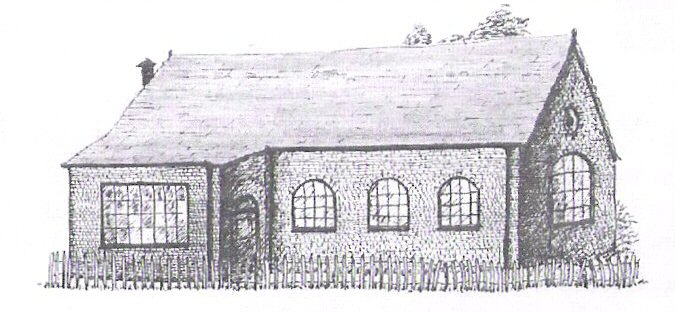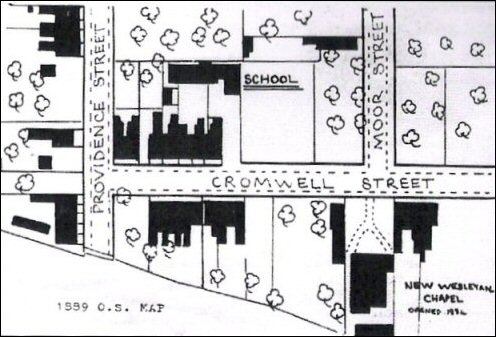

The Ribbon Weaving Shed (Earlsdon's first school)
In Cromwell Street (now Berkeley Road South) the little ribbon weaving shed, brick built and as near as can be estimated about 40ft by 20ft, was left empty and unused following the troubles that had afflicted the ribbon weaving industry. There had been a small group of weavers who had moved to Earlsdon after its creation in 1852, but Earlsdon's ribbon weaving history was shortlived and within 20 years they were gone. The ribbon weaving industry in Coventry was hit hard in the 1860s by thelifting of duty on imported French ribbon and as a result the industry almost collapsed and many weavers were left unemployed. The weaving shed remained empty until the year 1872, when it took on a new lease of life. Most of the early residents of Earlsdon, almost to a man involved in the watchmaking industry, were in their religion non-conformists. Baptists, Congregationalists, Unitarians, but mainly Wesleyan Methodists. However, there was no place of worship for any of them on the estate, the nearest being the Anglican church of St Thomas in the Butts, at the bottom of the Jetty. Every Sunday all Earlsdon churchgoers had to make the roundabout trip (via Hearsall Lane or Warwick Road), or the shorter unpleasant one down the Jetty to their city churches. By the end of 1872 the small band of dedicated Methodists decided that the time had come to establish a meeting place in Earlsdon itself, both for their own convenience and for others who couldn't or did not wish to travel into the city to attend church. But what could they do for premises? Well, there stood the old shed, empty and waiting, and the owner Mr David Spencer was willing for a very small annual sum to lease it to them for as long as they required it. The little group cleaned it up, put in some old pews and held the first service there in December 1872. In the early days the accompaniment for the hymns was provided by George Hollis playing on his concertina, although this was soon replaced by kind neighbours lending their harmonium, wheeled round on Saturday evening and returned after Service on Sunday evening. A bazaar held the following year provided funds for the purchase of a small American organ. By the following February a Sunday School had been started, although the children were far too distracted by the twittering of the sparrows as they hopped in and out through the holes left in the roof when the loom shafting had been removed. Education being of prime interest to the Methodist watchmaking fraternity, the Sunday School teachers also began to teach the 3Rs to those children who didn't already go to school in the city, but with the 1870 Education Act coming into force, it was realised that this was not enough. It was too much to expect the very young and frail children to walk into the city every day, particularly in bad weather; a properly organised day school was needed on the estate. In 1882 a small group of leading residents of varying denominations and politics formed themselves into an education committee and, by obtaining a grant from the British Schools Society and raising a small local rate of a few pence, they were able to lease the weaving shed on a weekday basis. They were also able to appoint a headmaster, young Charles Corelli Johnson, who was instructed to tour the estate and recruit as many children as he could. They bought some basic equipment, a few desks, some slates and chalk, a blackboard and a few books and also appointed Miss Lucy Satchwell as an assistant to teach the girls. On 24 April 1882 Earlsdon School officially opened with two teachers and 73 pupils and from then on attendance grew. Within a few years with the local population growing fast it was obvious that a larger purpose built school was desperately needed. In 1884 the Methodists moved to their new chapel on the opposite side of the road. Conditions got worse year by year, teachers and pupils alike were forced to endure them until 1890 when their new school opened on Earlsdon Avenue.
Other activities which had been taking place in the shed, political meetings, bazaars and concerts, now moved to the new premises. The shed was no longer needed and was demolished in 1893. It is only because it is marked on maps that we know of its location. Although it failed as a business venture it succeeded in other ways, serving the community until they were able to provide something better. |

